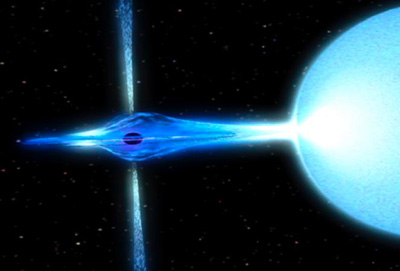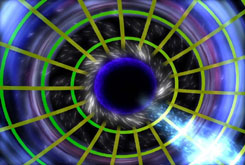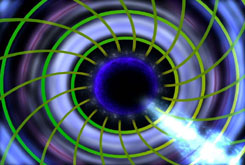Imagine the Universe News - 30 April 2001
Black Holes May Take Space For A Spin
| 30 April 2001 |

This image shows a closer glimpse of a spinning black hole. Gas can be seen forming a disk-shaped structure as it whirls around the black hole, like soap suds spiraling down a bathtub drain. |
As if black holes weren't menacing enough, astronomers now have observational evidence that at least some of them spin about like whirlpools, wrapping up the fabric of space with them.
Dr. Tod Strohmayer of NASA's Goddard Space Flight Center, Greenbelt, MD, has studied one such black hole system with NASA's Rossi X-ray Timing Explorer and found unique patterns in the X-ray radiation that have previously only been seen in spinning neutron stars. With these new parameters, he could verify that a black hole, like a neutron star, can spin.
The observation also challenges theories about neutron star radiation. Strohmayer presents his findings today at the American Physical Society Spring Meeting in Washington, D.C.
"Almost every kind of object in space spins, such as planets, stars, and galaxies," said Strohmayer. "With black holes, it's much harder to directly see that they are spinning, because they don't have a solid surface that you can watch spin around. We can, however, see the light emitted from matter plunging into the black hole. The matter whips frantically around the black hole before it is lost forever."

|

|
|
These two images are an
artist's concept illustrating the difference between a
spinning black hole (right) and one that is not spinning
(left). In both images, the central black circle
(surrounded by a blue glow), represents the black hole's
event horizon. The surrounding blue and white rings
represent hot gas whirling around the black hole. The
green grid depicts space-time coordinates. Note how the
spinning black hole (right image) distorts the space
time grid, allowing matter to orbit at a closer distance
than if the black hole were not spinning. (Image Credit: NASA/Honeywell Max-Q Digital Group/Dana Berry) (6 Mb QuickTime movie) (Description) |
|
The black hole that Strohmayer observed is the stellar variety, which is formed from a collapsed star. When stars at least 10 times more massive than our Sun exhaust their fuel supply, they no longer have the energy to support their tremendous bulk. These stars explode their outer shell of gas in an event called a supernova.
The remaining bulk, still several times more massive than the Sun, collapses into a single point of infinite density, called a singularity. Neutron stars form through a similar process, only from a slightly less massive star in which the inner core collapses into a dense chunk as heavy as the Sun yet only 10 miles across.
The Rossi Explorer, launched December 1995, has long recorded a certain type of X-ray flickering from neutron stars called quasiperiodic oscillations, or QPOs, caused by hot gas dancing around the neutron star in a lively orbit. Astronomers think that these oscillations are produced by motions of matter very near the innermost stable orbit -- the closest orbit a blob of gas can maintain before falling into the central object.
Strohmayer's target was GRO J1655-40, a microquasar 10,000 light years from Earth. A microquasar is a specific type of black hole with jets of high-speed particles shooting perpendicularly from the plane of matter that orbits it. Strohmayer observed two QPOs, a previously detected one at about 300 Hertz (Hz) and a newly detected one at 450 Hz.
The mass of the black hole in GRO J1655-40 has been established at seven times the mass of our Sun from earlier optical observations. "A spinning black hole modifies the fabric of space near it," said Strohmayer. "The spinning allows matter to orbit at a closer distance than if it were not spinning, and the closer matter can get the faster it can orbit. For GRO J1655-40 we can now say that the only way for it to produce the 450 Hz oscillations is if it is spinning."
Strohmayer's finding also marks the first detection of a pair of QPOs from a black hole. Neutron stars often exhibit paired QPOs, and this is thought to be a result of radiation coming from the solid neutron star surface. Strohmayer's detection of paired QPOs from an object with no solid surface, therefore, challenges these important theories of how neutron stars produce these QPOs. The spin of a black hole would be caused by the angular momentum of the star that formed it, Strohmayer said, particularly if that progenitor is a spinning neutron star.

